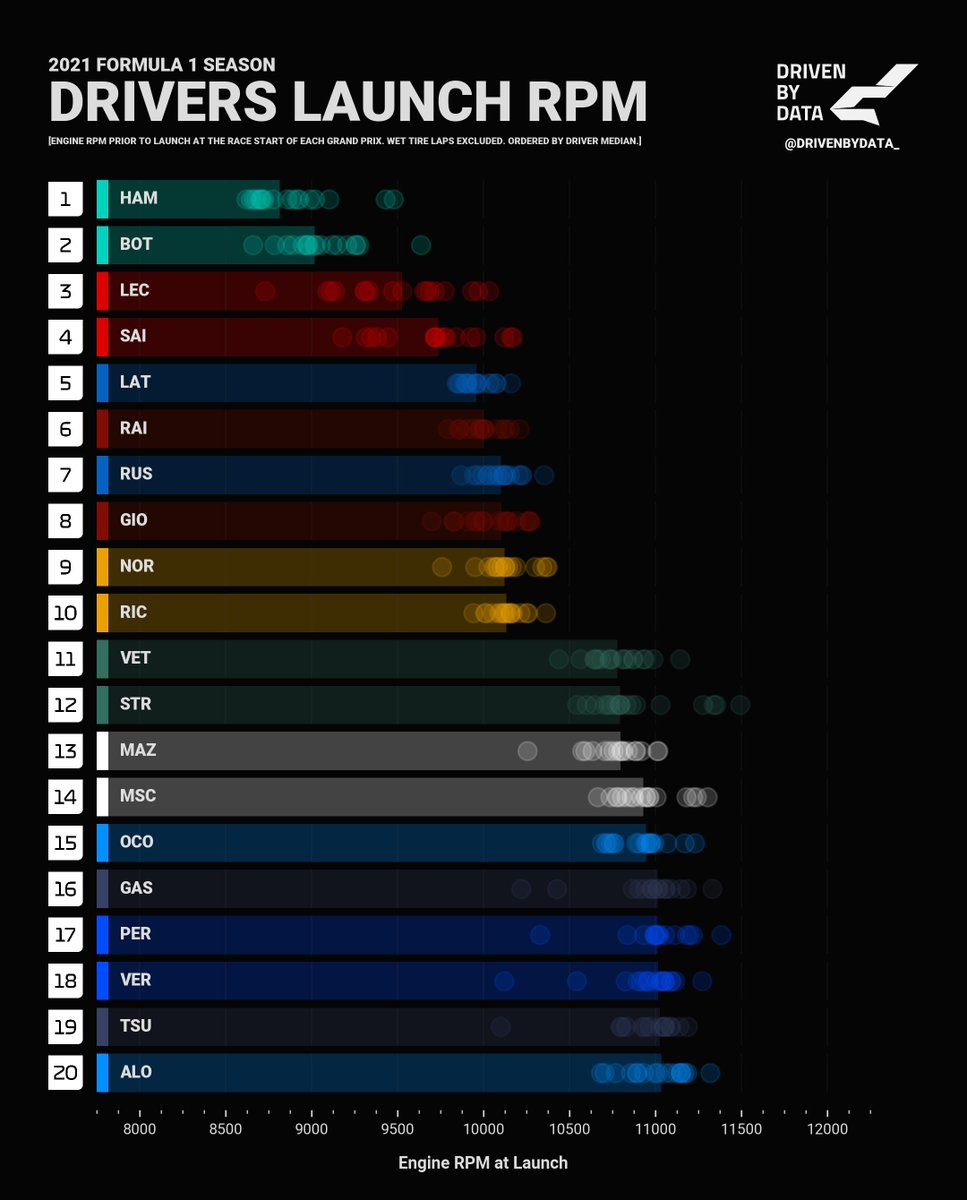
Upshift RPM Analysis for Drivers and Teams in the 2021 Formula 1 World Championship [Details below]
#F1 #Formula1

#F1 #Formula1


Featuring more than 300.000 upshifts recorded across the 22 Grands Prix of 2021, this dataset, while being an indirect metric, can point to how hard the teams have been pushing their power units (more specifically the ICE), throughout the season.
Running the engine at higher RPM will generate more internal friction, yielding more heat that has to be dealt with by teams and their cooling solutions. In addition, running at higher RPM will inevitably result in a more wear, shortening the lifespan of the engine.
Regulations on fuel-flow have made it favorable to maximise power/torque in lower RPM-ranges, since this will allow more "bang-for-your-buck" fuel-flow-wise, which is why we see a kind of "ceiling" at ~12.500 RPM that is rarely exceeded.
The horizontal bars indicate median upshift RPM per car/driver, while the vertical bar histogram denotes the frequency distribution in the displayed range.
Key takeaways:
- Mercedes, and especially Hamilton, have been upshifting at considerably higher engine RPM relative to their competitors across the season. This is somewhat unsurprising in terms of reliability since Hamilton ended up taking on 5 ICE's and Bottas 6.
- Mercedes, and especially Hamilton, have been upshifting at considerably higher engine RPM relative to their competitors across the season. This is somewhat unsurprising in terms of reliability since Hamilton ended up taking on 5 ICE's and Bottas 6.
However, with fuel-flow restrictions often being the limiting factor, Mercedes being able to run considerable higher RPM than Honda and Red Bull speaks to the efficiency of the Mercedes PU.
- To my surprise, there's a **huge** disparity between the Red Bull cars with Perez running 3rd and Verstappen only 18th in this metric.
Pure speculation here, but my take is that Verstappen has been running in "engine conservation" mode for much of the season, especially earlier in the season, where he could afford to stretch the life of his engine(s) whenever possible.
What Verstappen and Red Bull had "saved up" with this approach would then have been wiped out as they lost an engine in the crash on lap 1 of the British Grand Prix, forcing him to resume extending the life of his power-units in order to finish the season with just 4 engines.
- Haas running last even in this metric. Again, no more than speculation on my part, but it would make sense for Haas to conserve their engines in many of the races in the season. One reason is costs, engines are expensive, especially when you aren't going to get points anyway.
Another is that for many, if not all races this season, there was no way for a Haas to score points on merit. This leaves only one possibility of scoring points: finishing every race and hoping that 10 competitors DNF, which Mick Schumacher came close to achieving in Hungary.
Disclaimer
The source of this data is non-official. As a result, the precision and/or integrity of the data cannot be guaranteed. However, aggregating across a massive sample size should cancel out or at least substantially reduce potential errors and imprecisions.
The source of this data is non-official. As a result, the precision and/or integrity of the data cannot be guaranteed. However, aggregating across a massive sample size should cancel out or at least substantially reduce potential errors and imprecisions.
Data obtained using [FastF1](github.com/theOehrly/Fast…).
• • •
Missing some Tweet in this thread? You can try to
force a refresh





